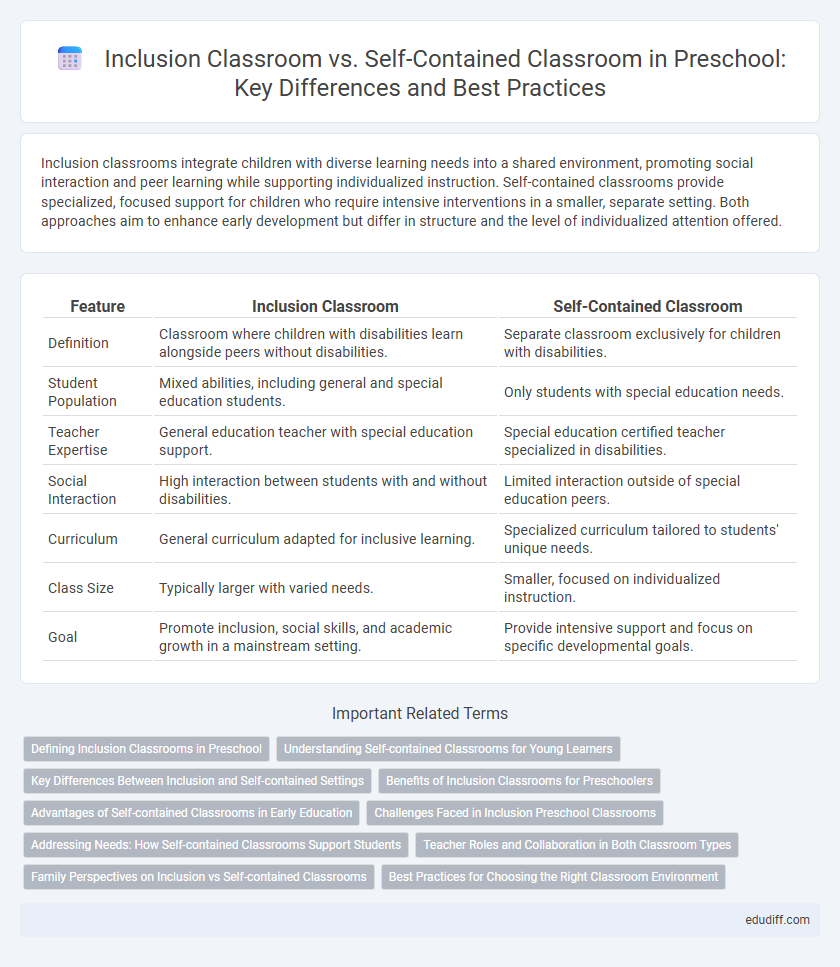Inclusion classrooms integrate children with diverse learning needs into a shared environment, promoting social interaction and peer learning while supporting individualized instruction. Self-contained classrooms provide specialized, focused support for children who require intensive interventions in a smaller, separate setting. Both approaches aim to enhance early development but differ in structure and the level of individualized attention offered.
Table of Comparison
| Feature | Inclusion Classroom | Self-Contained Classroom |
|---|---|---|
| Definition | Classroom where children with disabilities learn alongside peers without disabilities. | Separate classroom exclusively for children with disabilities. |
| Student Population | Mixed abilities, including general and special education students. | Only students with special education needs. |
| Teacher Expertise | General education teacher with special education support. | Special education certified teacher specialized in disabilities. |
| Social Interaction | High interaction between students with and without disabilities. | Limited interaction outside of special education peers. |
| Curriculum | General curriculum adapted for inclusive learning. | Specialized curriculum tailored to students' unique needs. |
| Class Size | Typically larger with varied needs. | Smaller, focused on individualized instruction. |
| Goal | Promote inclusion, social skills, and academic growth in a mainstream setting. | Provide intensive support and focus on specific developmental goals. |
Defining Inclusion Classrooms in Preschool
Inclusion classrooms in preschool integrate children with diverse developmental abilities, fostering an environment where typically developing peers and children with special needs learn side by side. These classrooms emphasize individualized support within a general education setting to promote social interaction, equitable learning opportunities, and skill development. Unlike self-contained classrooms, which separate children with disabilities, inclusion classrooms prioritize collaborative teaching strategies and adaptive curricula to meet varied learning requirements.
Understanding Self-contained Classrooms for Young Learners
Self-contained classrooms for young learners are specialized educational settings designed to support children with specific learning needs, offering targeted instruction and tailored resources within a small group environment. These classrooms provide intensive support by focusing on individualized curriculum adaptations, allowing educators to address developmental delays or disabilities more effectively than in general inclusion settings. Understanding the structure and benefits of self-contained classrooms helps educators and parents make informed decisions to enhance early childhood education outcomes.
Key Differences Between Inclusion and Self-contained Settings
Inclusion classrooms integrate children with diverse abilities in a general education setting, promoting social interaction and individualized support within the same environment. Self-contained classrooms separate students with special needs into specialized environments, offering tailored instruction and smaller class sizes focused on specific developmental goals. Key differences include the level of integration with peers, instructional approach, and accessibility to general curriculum activities.
Benefits of Inclusion Classrooms for Preschoolers
Inclusion classrooms foster social development by allowing preschoolers with and without disabilities to interact, promoting empathy and collaborative skills. These settings support diverse learning styles and encourage individualized instruction within a mainstream environment, enhancing academic growth. Exposure to varied abilities in inclusion classrooms prepares children for real-world diversity and cultivates a sense of belonging and acceptance.
Advantages of Self-contained Classrooms in Early Education
Self-contained classrooms in early education provide specialized environments tailored to the unique needs of children requiring intensive support, ensuring personalized instruction and consistent routines that enhance learning outcomes. These settings enable teachers to implement focused behavioral and developmental strategies, fostering a secure space that promotes social-emotional growth alongside academic progress. Concentrated resources and smaller class sizes in self-contained classrooms contribute to addressing individual challenges effectively, supporting children with disabilities or delays more comprehensively than inclusion classrooms.
Challenges Faced in Inclusion Preschool Classrooms
Inclusion preschool classrooms often face challenges such as managing diverse developmental needs and providing individualized support within a single setting. Teachers must balance curriculum adaptations while fostering social integration among children with and without disabilities. Limited resources and insufficient training further complicate effective instruction and behavior management in these inclusive environments.
Addressing Needs: How Self-contained Classrooms Support Students
Self-contained classrooms provide tailored support by grouping students with similar needs, allowing for individualized instruction and specialized interventions. These classrooms utilize adaptive curricula and therapeutic services to address developmental, behavioral, and learning challenges effectively. Concentrated resources and lower student-to-teacher ratios promote a supportive environment that enhances skill acquisition and social-emotional growth for children requiring intensive assistance.
Teacher Roles and Collaboration in Both Classroom Types
Teachers in inclusion classrooms foster collaboration by adapting lessons to diverse learning needs while working closely with specialists and families to support all students. In self-contained classrooms, teacher roles emphasize specialized instruction tailored to specific disabilities, often requiring individualized planning and consistent communication with therapists and caregivers. Both settings demand strong collaboration, but inclusion classrooms prioritize integrating students into general education environments, whereas self-contained classrooms focus on intensive, individualized support within a specialized setting.
Family Perspectives on Inclusion vs Self-contained Classrooms
Families often prefer inclusion classrooms for their preschoolers as these environments promote socialization, peer learning, and a sense of belonging among children with and without disabilities. Self-contained classrooms are valued by some families when specialized attention and tailored support are necessary to meet their child's unique developmental needs. Parental choice between inclusion and self-contained settings significantly impacts their child's social skills, academic progress, and overall preschool experience.
Best Practices for Choosing the Right Classroom Environment
Inclusion classrooms promote social development and diversity by integrating children with varying abilities, fostering peer interactions and collaborative learning. Self-contained classrooms provide specialized support and tailored instruction for children with significant developmental needs, enhancing individualized attention and targeted interventions. Evaluating each child's unique needs, family preferences, and available resources ensures the selection of the most effective preschool environment.
Inclusion classroom vs Self-contained classroom Infographic

 edudiff.com
edudiff.com